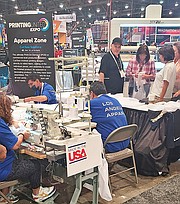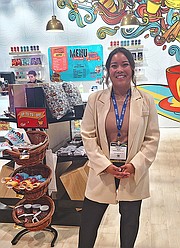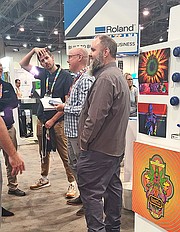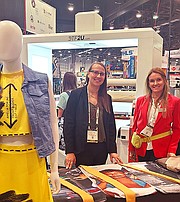Changing the Industry Through Technology Innovations, Communication

United Expo Printing, which was held Oct. 19–21 at the Las Vegas Convention CenterThe Printing Technology Marketplace is the world’s largest, most varied marketplace and an incubator for innovative ideas. The consumer-centric supply chain replaces the traditional seasonal development process and eliminates long time frames and action schedules. With the latest digital and software innovations, it is possible to track garments quickly and read and respond immediately to sales.
“This week has been surreal, seeing the industry come together after such a long time,” said Amanda Kliegl, vice president of public relations for the expo. “The direct-to-garment movement has brought many new customers to the show. Startups who initially began in their garages have grown and now are looking to see what’s available in technology and equipment to buy and build for growth,” Kliegl added.
Mimaki Demonstrated its micro-factory with strategic partners Tukatech, Greentex, Beaver Paper, Kieverik And Juki. The new generation of production offers same-day design, which reduces waste and eliminates minimums. It also allows for quick turnaround, which solves many problems previously associated with the manufacturing process. The three-step process of printing, finishing, and assembly allows for products that are ready to sell in hours instead of weeks or months. Victoria Nelson Harris, Mimaki’s senior textile specialist, said, “The micro-factory gives full control of the supply chain with instant production, which is really cool. The complete solution.”

Chris Walia, COO of Tukatech, added, “Technology is so amazing yet underutilized in the apparel industry. We are poised to help companies make the necessary transition by providing cutting-edge product.” One of his goals is to promote micro-factories within the U.S. for speed to market.
Take a look at Epson, Six-color printers were introduced, as well as a color match system. This color-matching system can read any sample of material and produce the exact color with the touch of a button. Tim Check, senior product manager for textiles, said, “This is another new tool to assist creatives, where their vision comes to life, communicating directly with the printer.”
X-Rite Pantone Software and machinery has been improved to accurately measure specific color, eliminating the need for color approval. Queenie Bhardwaj, product manager, said, “We are now able to make sure color standards are exact and can be given to our customers by elevating the visual process.”
HP’s innovations in digital printing allow for the elimination and expense of burning screens for small orders. Rolando Martinez, global head of programs and solutions, spoke to improvements in the area of packaging, “Today’s trend is definitely toward smaller runs. It is easier to package for small businesses. Low MOQs for testing, fast turns and greater profitability are now achievable.”

Roland The company presented its full-color photo printing solution using digital dots. The direct-to garment printer can produce up to twelve pieces per hour. For entry-level garment makers, the new equipment comes with a heat-transfer device. This equipment is an affordable solution for direct-to consumer sellers such as those who sell with Etsy There are now stores that can make their own products at home, without needing to spend a fortune.
Los Angeles Apparel I was there to meet screen printers and wholesalers. Pat Honda, president of wholesale, said, “We are reaching everyone who will touch our product before the end user. We’ve seen some customers from as far away as Canada. Connecting in person again has been great.” The company’s stock program of knitwear and accessories is available in custom colors for a 300-piece minimum in seven to 10 days. Its 6½-oz. It is available in 26 colors and costs just $6.50.
Gerber Technology The show also featured its customization and on-demand technologies. The company’s photo-image printing capabilities create lifelike images on textiles that look like denim.
Omniprint International monthly panels that help companies scale up and grow, and address the important of TikTok Social media in general. The panel included influencers, who discussed the difficulties they had in growing their businesses and addressed questions from the audience. Chazz Owens is the CEO of Streetwear Brands. Twozzday And 222 Sport, said, “When I heard about this show, I thought I would check out what’s new and available for growing my brand. I’m looking to expand my line beyond online by collaborating with licenses and will need to be able to present collections and samples more quickly.”

The Kornit Conference was held at the end of the expo’s first day. Ronen Samuel, CEO of Kornit Digital, opened the seminar and passionately spoke about wanting to “be the change” that is long overdue. “After three long years it is a pleasure to be in person,” Samuel said. “We are making fashion better, faster and more personal. The industry has seen so many changes in technology over the past three years, and now we want to make it better. Fashion is one of the last industries to go digital.”
Samuel said that it is important to tackle disruption through change. “There’s been a big e-comm boom, especially during COVID, which has made social media so important to what the consumer is responding to. The ability to produce what is actually sold, never run out of bestsellers and same-day reorders are just some of the customer-first changes,” Samuel explained. “What’s important to Gen Z is sustainability, and the industry is currently the second-biggest polluter. Kornit has made a commitment to tackle this issue and produces an environmental impact report to track these improvements.”
Don Whaley is the vice president at Kornit Digital. This cycle allows for rapid product development and closer integration with existing systems. A new equipment was introduced, including the Max System which prints directly to fabric. Coming soon is the Apollo, in which one person can produce 350–400 fully finished garments per hour.

